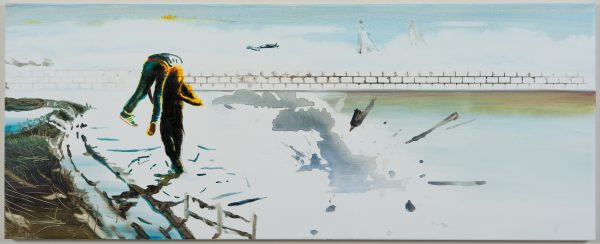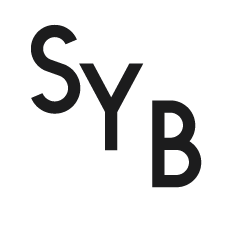15 September till 21 October 2015
In foreign parts
Review by Julia Steenhuisen

John Kørner and I are looking at one of his paintings. Floating above a vast horizon we see a man walking; he carries a bundled-up body over his shoulder. Next we look at a seascape with an enlarged sneaker floating on the surface. They are allusions to the refugee crisis. On the next canvas we see a mountain landscape with a brick wall, and on another a panaroma with an enlarged white, plastic chair. The world that Kørner creates, is formed by brush strokes, splashes and colour. That he uses recognisable, contemporary elements makes his work slightly disconcerting – yet, at the same time it adds a certain importance and signifiance to it, Kørner explains.
I think of Camus’ novel L’Étranger when seeing Kørner’s work – a seemingly simple tale of a man who wanders in a world without purpose or meaning. When the indifferent main character Meursault finds himself drawn into a conflict on a beach, he ends up killing a man without clear motive. ‘It was the sun,’ he declares in court, holding out against the further need to defend his actions. In the end he is condemned to the gallows. L’Étranger praises life on earth over the metaphysical existence. A world without authority to fall back on, or a hereafter to soften the wretched transcience. Meursault’s sense of absurdity doesn’t spring from insensitivity but apathy. An emptiness towards the world, an alienation from life.
It’s that same alienation I see when Kørner shows me what he created in Kunsthuis SYB. The works he produced are all oriented horizontally, vast, green with grey skies. They reference the Dutch landscapes and the many famous paintings that depict them – and in such are a deliberate confirmation of the prejudices that surround this environment. Though, was it this landscape that I saw during my bus drive over? It was Monday when I started my journey from Amsterdam to Beetsterzwaag. To Heerenveen by train, from Heerenveen to the Hoofdstraat in Beetsterzwaag by bus. The bus! Intrigued by the landscape I stared outside, to the industry that took possession of the land. Uprooted from what is familiar to me as city dweller, I caught myself dwelling on rural exoticism. Once I arrived at Kunsthuis SYB, Kørner told me about his own observations of the town. His bewilderment was similar to mine. Kørner finds the people strange, and the people find him strange. He tells me about a stroll in the forest and how it familiarised him with the area, but also how he seemed to scare off other hikers.
As night falls, Kørner and I decide to eat in the Hoofdstraat. Monday evening brings us to the only open establishment: snack bar De Jong. The tables are covered with tablecloths, the woman behind the counter helps us attentively, in feeble English. Kørner continues about his family who were originally from Danish Friesland, which gives him a connection with the area. Yet he tells of how, in preparation for his residency, he drew exclusively from his imagination. He sees potential in Friesland for a new form of agricultural, but did not use any sources or archives for specific research. His research was exclusively grounded in creative thinking. Not being too involved seems Kørner’s way of keeping the world at arm’s length. The residency too, is an attempt to displace himself. But it is this process that allows Kørner to build a world without any logical coherence; an irrational world.
How tempting it is to describe unlikely, dream-like depictions as references to the subconscious. How simple it also is to understand an explosive style of painting as mystique, as a glimpse of a metaphysical reality. The fluid, aqueous paint Kørner uses in his landscapes does make them elusive and erratic. Possibilities and improbabilities merge. But by no means is this an allusion to another reality. It seems a portrayal of the life of modern man, who, just like Meursault, moves through life fleetingly and blindly, in unfettered relativity.
